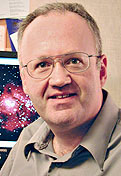 |
|
|

BOOK SALE - I'm selling off some scholarly books via Amazon Marketplace. Have a look!

|
2006
October
30-31
|
PC reboots over and over, showing only BIOS screen
We thought Eos, our home server, had lost a disk drive yesterday evening.
It hadn't. Here's the story.
The symptom: The PC was rebooting over and over. It would go through
the BIOS self check, the screen would go blank, and the whole thing would
start over again.
Dead disk drive?
No. We extracted Eos's boot disk and attached it, as drive E, to another computer.
It worked just fine. We quickly copied all the files that had been altered since
the last backup.
Then I ran CHKDSK and a virus scan. No sign of anything wrong.
At this point I was still thinking about
corrupted master boot records,
except that CHKDSK didn't complain of any such thing.
So I started following Microsoft's instructions to
make a boot diskette which would load Windows from the hard disk
without having to actually boot from the hard disk.
I learned that in order to boot Windows XP, a disk must have on it:
- A master boot record that makes it bootable.
- The files ntldr, ntdetect.com, and boot.ini.
Those files are normally hidden files in the root folder of C:.
To see them, open up drive C and go to Tools, Folder Options, Advanced, Show Hidden Files and Folders.
Well... To make a long story short, the boot disk of Eos didn't have ntdetect.com on it.
Nobody knows why.
Something went wrong while Melody was installing Windows updates a while back.
I just copied ntdetect.com into place and the problem went away.
I'm going to run a full virus scan soon.
Permanent link to this entry
Comet SWAN (C/2006 M4)
Before coming home to grapple with ntdetect.com, I got out into the country
briefly just after twilight to photograph Comet SWAN.
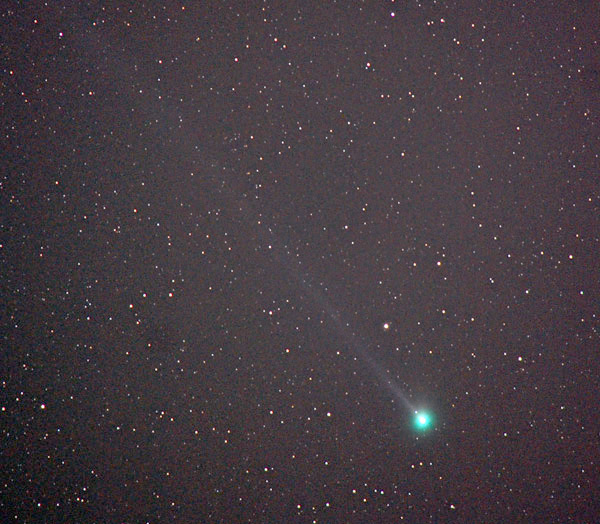
This is a 4-minute exposure with a 300-mm f/4 lens.
I used a Nikon D80 and allowed the infamous
star eater to do its work.
Of course it didn't eat any of the comet.
I tend to think that it should be used freely to produce a higher-quality picture
whenever faint stars are not of interest.
This comet was discovered by the orbiting Solar Heliospheric Observatory (SOHO)
and specifically by an instrument called the Solar Wind Anisotropies (SWAN) probe.
Permanent link to this entry


|

|
2006
October
29
|
Nikon does the Pleiades
I'm still trying out a Nikon D80 lent by Nikon USA.
Here's last night's catch. Under suburban skies (mag. limit 4.5), I took a single
5-minute exposure of the Pleiades (Mode 3, ISO 800, 300-mm lens, f/4)
and a single dark frame, then
did the processing with MaxIm DL. You can see lots of stars and some of the nebulosity.
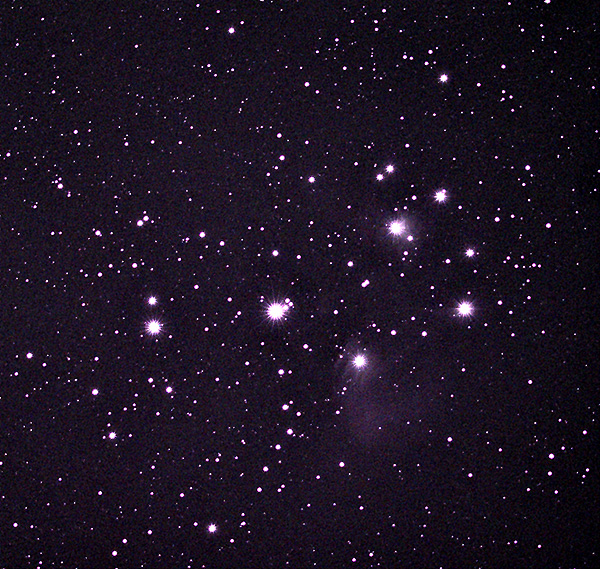
I focused this Nikon with my Canon Angle Finder C.
It fits and works well.
Permanent link to this entry


|

|
2006
October
28
|
Old cameras
Since the last time I looked at it, the Internet's supply of
web pages about camera collecting and old cameras
has really blossomed.
See for example
Frank
Mechelhoff's Cameras of the 1950s, 60s, and 70s (partly in German);
Zeiss Historica;
Sylvain Hagland's collection (in French;
click where it says cliquez ici);
Wim Wiskerke's Olympus page
(look carefully and find my name on it; hmmm, I leave my mark too many places...).
This is relevant because old lenses with the M42 (Pentax) screw thread adapt well
to the Canon EOS. So I'm looking at vintage Super-Takumars, East German Zeiss lenses,
and so forth...
Permanent link to this entry


|

|
2006
October
27
|
Miscellany
Have you seen
Comet SWAN yet?
I haven't; it's raining cats and dogs.
Read (or even listen to)
the
world news in Latin,
from Finland.
It's surprisingly popular.
Curiously, the Finns speak one of the few languages in Europe that
are not related to Latin at all.
But the sound system of Finnish may give them an advantage
pronouncing Latin vowel-length distinctions.
Finally, a name for
the way most of us manage our money.
Pundits say "you need a budget" but what we really need are habits.
This pundit has finally admitted it;
he calls it "intuitive finance."
Read the second half of his article, not the gloomy first part.
Finally, you can
print images photographically onto a living geranium leaf
by projecting the image onto a light-starved leaf long enough to influence
the formation of chlorophyll.
Permanent link to this entry


|

|
2006
October
26
|
Must all tools be Swiss Army Knives?
Reflections on a cell phone I didn't like
Today I resold the
Samsung SGH-D407 cell phone that I had been using for
a couple of months.
It was driving me crazy.
The reason?
It has buttons on the side which are not shut off when the phone is closed.
With the phone in its belt holster, if I moved around while sitting down, I would
often provoke a beep
and sometimes even make the phone dial a number ("Voice Command").
The only way to prevent all of this would be to turn the phone off.
Closing it up while it's on didn't suffice.
I think this is a symptom of a general design problem with modern electronic gadgets,
something that used to be called creeping featurism.
Without making the phone any bigger or more rugged, the maker can add a few buttons,
rewrite the firmware, and presto! — the phone has more features.
And features are why people buy cell phones, right?
No. I bought this phone to make and receive phone calls. The built-in camera would
have been handy if there had been a good way to turn it off!
But those side buttons, "live" even with the clamshell closed up, were
a misfeature.
Master carpenters don't do most of their work with Swiss Army Knives.
A Swiss Army Knife is a handy multipurpose tool, but it is not the best knife,
nor the best screwdriver, nor the best corkscrew...
The embedded systems industry needs to stop trying to build Swiss Army Knives
and get back to building tools that are good for their main purpose.
Permanent link to this entry


|

|
2006
October
25
|
Internet Explorer 7 problems
Nothing happens when you click on a web link in Outlook Express
or when you type a URL at the Start Menu "Run..." prompt
Internet Explorer crashes when logging onto an Amazon.com account
Two Internet Explorer 7 problems presented themselves today.
(1) Web links in Outlook Express, and possibly other software, do not work;
nothing happens when you click on them.
Also, web addresses do not open if you type them at the Run... prompt on the
Start menu.
In the Internet Explorer 7 "Tools, Internet Options, Programs" menu, IE7 always
thinks it is not the default web browser.
If you set it to default, the setting doesn't stick.
The solution was to log on as Administrator and set IE7 as default web browser
in the menu just mentioned and also by using Set Program Access and Defaults.
Then the individual user accounts worked properly.
(2) IE7 crashes when logging onto an Amazon.com account.
I have no cure for this one; my workaround was to use the Opera Browser.
Permanent link to this entry
Hidden menus for WAP (GPRS) and MMS on T-Mobile Samsung X495
Avid readers will recall that I bought an
unlocked Samsung X495 cellphone
(containing T-Mobile firmware)
a while back.
I use it on Cingular but can't access Cingular's Internet services,
such as the ability to receive pictures and ringtones.
Now I think I can get around that limitation. Two crucial discoveries:
- Dialing *#VSWAP# (*#87927#) brings up the WAP menu.
- Dialing *#VSMMS# (*#87667#) brings up the MMS menu.
Now I need to get Cingular to give me the codes, and I'll be all set up
(I think!).
Note added Oct. 26:
You'd think that Cingular's setup instructions
for the Samsung X497
would be just what I needed. They don't seem to work.
I'm going to recheck everything, but does anyone out there have a solution?
Oct. 28: A Cingular technician says they've seen this before; phones with T-Mobile's firmware
will not access Cingular's GPRS system even when the settings appear correct.
Note to anyone who finds this information useful:
I've told you all I know.
Please don't write with further questions.
Permanent link to this entry


|

|
2006
October
24
|
Astrophotography with a Nikon D80
Courtesy of Nikon USA, I'm trying out a
Nikon D80 digital SLR.
It arrived today. Here's a picture I took this evening:

Now this may not be the
finest picture of M31 I've ever taken,
but it was the easiest, by far.
This is a single 30-second exposure through a Nikon 180-mm lens at f/3.2,
with the camera riding piggyback on the telescope.
Dark frame subtraction was performed in the camera.
To process the image, I opened the JPEG file in Photoshop,
hit "Auto Levels," then cropped and resized it and adjusted the contrast just
a little more.
No astronomical software involved, and almost no time!
The D80 has the same "star eater" as the D70, D70s, and D50,
and the workaround is the same.
I had hoped that turning off "High ISO NR" (a new setting on the D80)
would stop it from eating stars, but no such luck.
Still, with every successive camera, the pixels are smaller and stars are
less likely to get eaten (that is, less likely to get mistaken for hot pixels).
I should add that, in my test, the stars that were eaten were very faint and might not
be missed.
I was using a 180-mm lens at f/5, giving a clear aperture of 36 mm, and exposing for 30 seconds at ISO 800.
Using the workaround, I was able to see stars of magnitude 15!
That is fainter than the human eye can see with an 8-inch telescope.
With the camera working normally, the magnitude limit was about 13, which is still impressive.
Permanent link to this entry


|

|
2006
October
23
|
Internet Explorer 7 is here
 Internet Explorer 7 (IE7),
to which I gave a lukewarm review
back in February,
is officially here,
I'm using it, and it looks good.
Internet Explorer 7 (IE7),
to which I gave a lukewarm review
back in February,
is officially here,
I'm using it, and it looks good.
(For a couple of problems found subsequently, see October 25.)
The biggest new features are tabbed browsing and greatly improved printing
(important because I often capture a web page by printing it to Adobe PDF).
There is also a phishing filter to protect you from the bad guys, and a very handy way
to add additional search engines to the menu.
You can add almost any search engine this way; I added the
ESV Bible.
The technique is to go to any search engine,
search for TEST, and give IE7 the URL that you get back.
IE7 will then construct search URLs substituting your query for TEST.
But I'm going to stop using target="_blank", a feature of HTML that was,
until today, copiously used in this blog.
Links with the attribute target="_blank" open the new site in a new window or a new tab.
In IE7, by default, this starts a whole new instance of Internet Explorer — which is
awkward. In Opera or Firefox it only starts a new tab.
While researching this, I learned that
target="_blank" is no longer recommended by the HTML gurus.
The reason?
It conflicts with the way blind people browse the Web.
They can't keep track of new windows popping up everywhere.
So, as of today, right-click and choose "Open in new window" if you want any of my
links to pop up as a separate page. Otherwise, the linked page will replace the one you
are looking at.
There's one more change.
If you want to open a remote FTP site as a Windows folder, that is now done
in Windows Explorer rather than within IE7 (even though IE7 is handling it for you).
Just open up My Documents, type the FTP URL
(which can be ftp://username:password@site.com),
or choose it from Favorites.
Permanent link to this entry
How to set up Internet Explorer 7
I recommend changing a few defaults when you install IE7. Here is my procedure:
(1) Download IE7 here.
(2) Log on as Administrator and install it.
(2.5) Reboot, log on as Administrator again,
start IE7, and go to Tools, Internet Options, Programs.
Set IE7 to be the default web browser.
Also use Set Program Access and Defaults to make
IE7 the default web browser.
These steps are necessary to eliminate dependence
on IE6, which is no longer there. If you skip them, users may have trouble
with web links in Outlook Express or other programs.
(3) Reboot, log on as yourself, start IE7, and make the following settings:
- On the opening screen, select the search engines you want.
I suggest Google, Wikipedia, and Amazon.
- Also from the opening screen, consider leaving the phishing filter turned off.
It slows you down. If, on the other hand, you think there is any chance you
could be a vicitm of phishing, turn it on.
- Tools, Pop-Up Blocker, turn on.
- Tools, Manage Add-Ons, Enable or Disable, and get rid of Google Toolbar (if you have it)
and possibly others that you don't recognize.
- Tools, Internet Options, General, Tabs – Settings, Always open pop-ups in a new tab.
(This will keep target="_blank" from spawning multiple copies of IE7.)
- Tools, Internet Options, General, Appearance, Fonts, change the default font
from Times New Roman to Georgia. Much more legible! This will only affect web pages
that do not specify their font.
- Tools, Internet Options, Programs, make sure IE7 is the default web browser.
There! You've moved in. Enjoy IE7.
Permanent link to this entry


|

|
2006
October
22
|
Oddest psycholinguistic phenomenon I've heard of lately
There are
several
reported cases of people who, while waking up from general anesthesia, can't speak their native
language, but can speak another language, typically one they learned in adulthood, haven't mastered,
and may even think they've forgotten.
Permanent link to this entry


|

|
2006
October
21
|
SAS crashes: "Library WORK does not exist"
I had an odd problem running SAS 9.1
on a Windows XP workstation today.
When starting up, SAS crashed with the error messages:
ERROR: Library WORK does not exist.
FATAL: Unable to initialize the options subsystem.
ERROR (SASXKINI): PHASE 3 KERNEL INITIALIZATION FAILED.
Then I discovered that if I logged on as Administrator, I could still run SAS.
I Googled the error message and saw some descriptions of it under UNIX; the gist is that
SAS's default workspace (the WORK library) is in a directory for which the user does
not have write permission.
Under Windows XP, the problem turned out to be the same, but with a strange twist.
SAS was wanting to put the WORK library in
C:\Documents and Settings\All Users\LOCALS~1\temp
which is a strange place to put anything. In the first place, "All Users" is for
files that belong to all users, such as the icons that are on everybody's desktop.
In the second place, "LOCALS~1" was apparently a strange way of trying to render
"Local Settings" in DOS format. There is supposed to be a folder named Local Settings,
but SAS wasn't using it. Instead, SAS created a folder named LOCALS~1.
This configuration information is stored in
C:\program files\sas\SAS 9.1\nls\en\SASV9.CFG
with a stiff warning not to change it since it's set by the installation program.
Anyhow, I don't know if variables such as
%USERPROFILE% are permitted in the .CFG file,
or I might have tried to edit it despite the warning.
As it is, I temporarily gave everyone full control of the LOCALS~1 folder,
and SAS ran correctly.
The remaining question is: Do our ordinarily very competent friends at SAS Institute not
quite appreciate the multi-user aspects of Windows,
or did one of my technicians make a really strange choice when installing SAS?
Permanent link to this entry
Miscellany
Student of the day:
One of our undergraduates decided to sell drugs and, er,
advertise it on MySpace.
Not a wise move.
If you like complicated cause-and-effect relationships,
consider Mankiw's account of
the Fed
shares power with its observers and critics.
Food for thought if you're involved in running any kind of organization.
Reading lamp:
I bought Melody one of these
the other day, and it worked out so well that I've ordered one for myself.
It's not perfect — it tends to illuminate one side of your book more than the other —
but we'll work that out.
The full-spectrum light takes advantage of the fact that the human
eye is slightly farsighted in red light and nearsighted in blue.
Thus, if you fill in the blue end of the spectrum, you help the eye focus closer.
This lamp is also sold under the
Tensor name.
Ott-Lite is another, better-known brand of full-spectrum lamp.
Permanent link to this entry


|

|
2006
October
20
|
Finally, the rest of those pictures
Here are the last 3 pictures from last month's flurry of activity.
These were taken on September 15, and each is a composite of several
3-minute exposures through an 8-inch telescope at f/6.3 with a
Canon Digital Rebel.
First, "Ptolemy's Cluster," M7, a bright cluster known since ancient times:
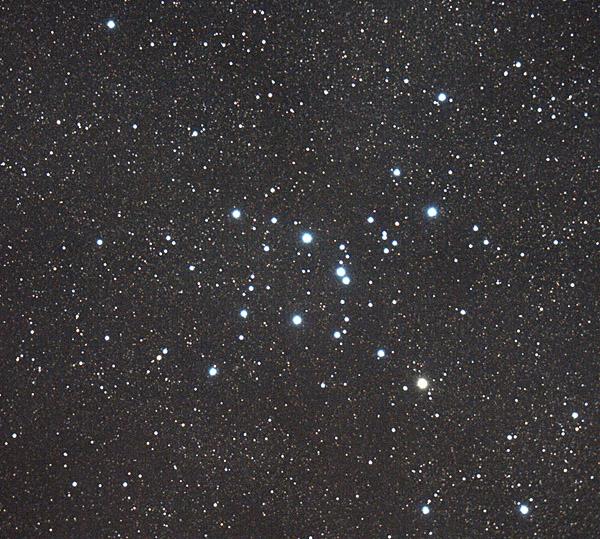
Color-corrected picture posted December 20.
Next, M13, the famous globular cluster in Hercules:

Color-corrected picture posted December 20.
Last, the globular cluster M22 in Sagittarius:

Color-corrected picture posted December 20.
Enjoy!
Permanent link to this entry


|

|
2006
October
19
|
Failed prognostication
Two months ago I predicted that
the interest rate on
Series I Savings Bonds
was about to shoot up again, to 6% or more.
The reason? These bonds are indexed to inflation, measured as pairs of points 6 months apart.
Because of random fluctuation, the measurement happened to be
to be extra-low across the last 6-month measurement period, so it ought to be
extra-high across the next one.
I prognosticated a CPI-U of 205 for September, as against 199.8 in March.
But in fact, after hitting 203.9 in August, the CPI-U subsided back to 202.9 in September,
so the interest rate for the next period will only be about 4.5%.
More here.
Permanent link to this entry


|

|
2006
October
17-18
|
Neuroscience 2006
I just got back from 2 days at Neuroscience 2006.
This was more a molecules-and-neurons conference than a cognition-and-behavior conference, so it didn't
coincide closely with my interests; but in a conference with 21,000 registered participants, there was
plenty that interested me.
I found two really good statistics books by Mitchell H. Katz.
Click
here
and
here
for details.
(Newcomers to the Daily Notebook who don't understand why a statistics book could be exciting
should click
here
to fill the gap in their education.)
I also got to see a lot of gadgetry. The best application of AI was a computer vision system that watches
a rat, 24 hours a day, and spits out a quantitative report of its behavior.
There's also lots of image processing, optics, and photography.
I even had a conversation with a maker of
nebula filters for astronomy
(it turns out the same filters are used in ultraviolet microscopy).
The most interesting biological demonstration was a microscope view of a live zebrafish fry (2 mm long);
I could see the heart pumping and the blood cells circulating. Several microscope vendors were
showing this. There's even a whole
scientific journal
devoted to zebrafish.
The most disconcerting thing I saw — but quite utilitarian, if you think about it —
was a guillotine for rats.
Permanent link to this entry


|

|
2006
October
16
|
More pictures
Here's the Eagle Nebula (M16), a composite of several 3-minute exposures through my 8-inch
telescope at f/6.3, using a Canon Digital Rebel. This is rather underexposed and is somewhat
the worse because of the extreme contrast stretching that had to be done.
A Hubble picture of the three dark nebulae in the middle of
this object was titled "The Pillars of Creation."
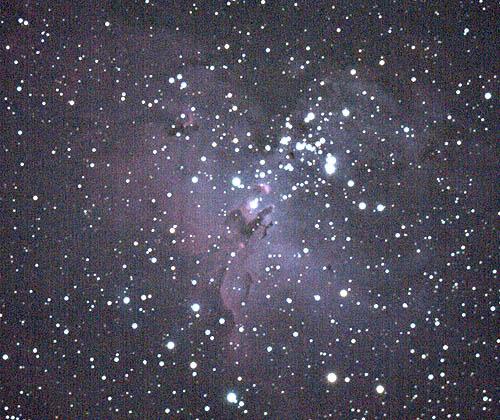
Color-corrected picture posted December 20.
Here's the galaxy M33 seen through the same setup, together with some of its nebulae, especially the bright
orange-red cloud in the upper left part of the picture, close to a star and far away from the center of the
galaxy.
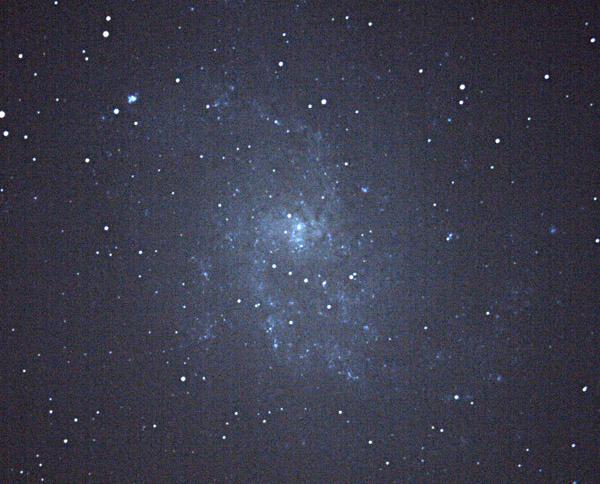
Color-corrected picture posted December 20.
And here's the central part of the Andromeda Galaxy (M31), a much brighter object,
photographed the same way. Note the clouds of interstellar dust in the galaxy.
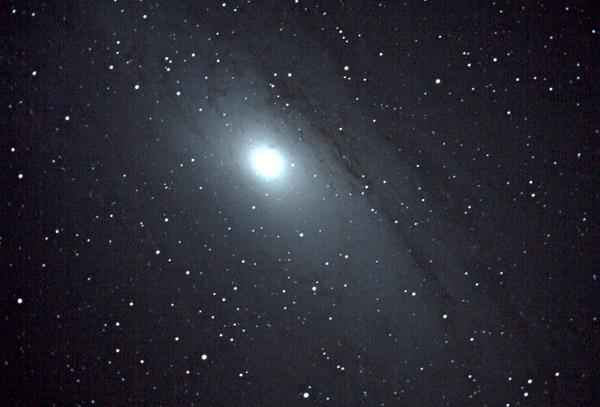
Color-corrected picture posted December 20.
Finally, here's the
North America Nebula
through a 105-mm Sigma telephoto lens with wire crosshairs added to produce diffraction
on the brightest stars.
This is a hydrogen-alpha nebula photographed with a Digital Rebel camera that hasn't been modified to
increase hydrogen-alpha sensitivity.
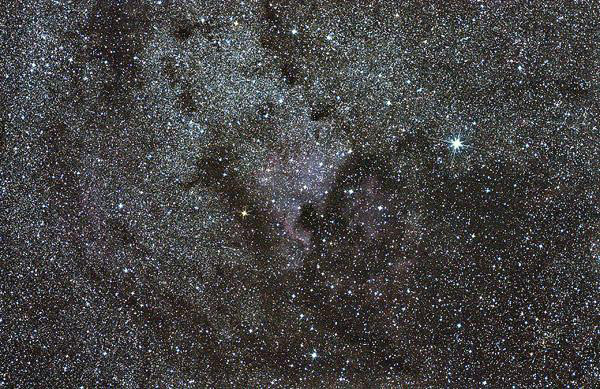
Color-corrected picture posted December 20.
Permanent link to this entry
Giant brains?
I'm about to attend about one day of
Neuroscience 2006, a convention that
is bringing 35,000 brain researchers to Atlanta.
Reportedly, on Saturday the skyline of Atlanta was adorned with a
hot-air balloon in the shape of a
gigantic human brain.
(See also this.)
As usual, the mind boggles.
Permanent link to this entry


|

|
2006
October
15
|
Uploaded early! Read tomorrow's news today!
M31 the hard way, and other pictures
I'm finally getting through my backlog of digital images to process.
Here, from Friday night's expedition, is the Andromeda Galaxy (M31):
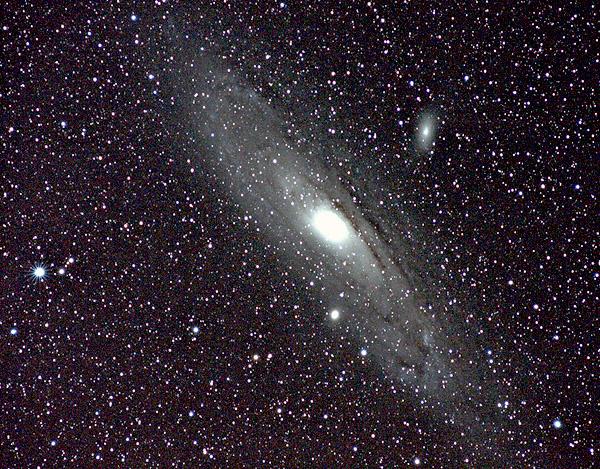
Copyright 2006 Michael A. Covington. Reprint rights available.
Color-corrected picture posted December 20.
That's the sum of three 6-minute exposures with a Canon Digital Rebel at ISO 400
piggybacked on an autoguided telescope, using a Nikon 300/mm f/4 lens at f/5.6
with a lens mount adapter. The image was processed with MaxIm DL and Photoshop CS2.
Near M31 in the sky is another galaxy, M33, which I photographed the same way:
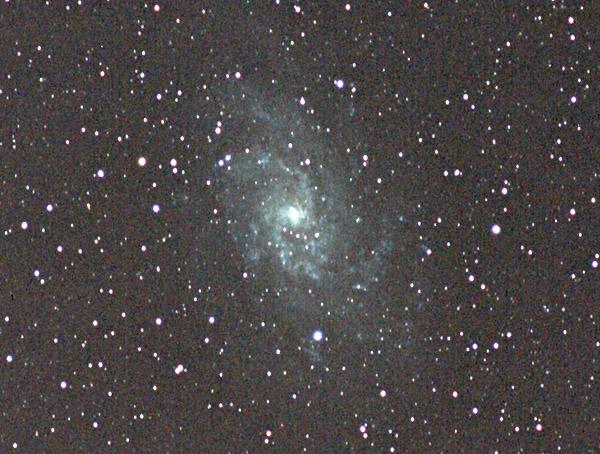
Color-corrected picture posted December 20.
This is a more magnified image because M33 appears smaller in the sky.
And here is the faint and elusive, but colorful, Helix Nebula (NGC 7293)
in Aquarius. This one was taken through an 8-inch telescope at f/6.3;
like the others, it is the sum of three 6-minute exposures followed by
considerable digital processing.
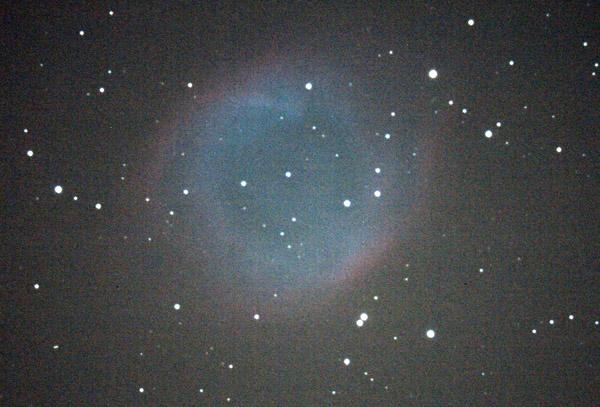
Color-corrected picture posted December 20.
The last object I photographed Friday night was the Merope Nebula, a faint
reflection (dust) nebula in the Pleiades star cluster.
This was also taken through the telescope, but the Pleiades were not high in the sky,
and the sky background was not dark.
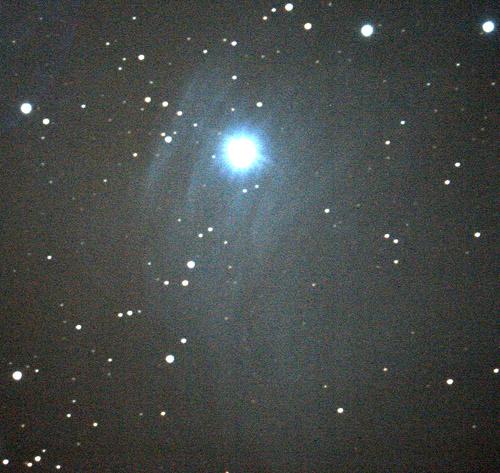
Color-corrected picture posted December 20.
Permanent link to this entry
Extreme programming? Extreme engineering?
Since about age 16, I've approached all large projects in a way that didn't have a name —
I just thought it was the smart way to build things — but now it's in vogue and,
among software developers, it's called extreme
programming.
Unfortunately the Extreme Programmers seem to be in a hurry to make up jargon
to complicate and obscure their main idea. Extreme Programming may be about to collapse
under its own weight, which is just as well since the name struck me as silly in the first place.
But the key idea behind it is sound: Build in steps, and make every step testable.
That is, get to a working program (with partial functionality) as quickly as possible, and
then add functions to it one by one, testing as you go.
This is far better than the rival approach: Write code for 3 months and then hit "run" for
the first time. Naturally, it won't run. Spend another 3 months figuring out why.
I did Extreme Programming long before it had a name.
And I take a similar approach to large electronic projects.
In fact, this is the only way I can avoid being daunted and frightened by
a complex project.
I'm not the kind of person who wants to follow 1,000 step-by-step instructions,
plug in the finished product, and be amazed if it works, or dismayed if it doesn't.
My approach is to build in modules and test the modules individually.
If I were building a stereo amplifier, for instance, I'd probably start with the
power supply. It's easy to test, and you need it to test anything else.
Then build the output stage for one channel;
try it out; do the same thing for the other
channel; and add the other stages one at a time.
This gives me abundant opportunities to track down problems and correct my own
misunderstandings.
I don't know if a house can be built that way,
but with a house, it's easier to look at things and see if they're right,
without having to test them in place.
I think there are people who have built summer homes
and mountain cabins incrementally, starting with the simplest usable structure and
then adding features step-by-step.
Why do I work this way? Because I don't think I'm all that smart.
I know I make mistakes and misunderstand things.
The machine always works the way it is supposed to,
which may be quite different from how I think it's supposed to.
Right now I'm teaching 68HC11 assembly language.
I see my students try to write 1000-line assembly-language programs without comments,
without clear division into sections, and most of all, without trying to write and test
just part of it first.
When they run into trouble, I always start by temporarily removing parts of the
program until I reduce it to something we all understand.
Then I put the deleted portions back in, one by one, until we get to something
that doesn't work the way we expect.
Then we hunt down the problem.
The idea here is to get the computer itself (or the machine I'm building)
to do the hard engineering work for me and reveal its own secrets.
I figure it knows how it works better than I do.
Permanent link to this entry


|

|
2006
October
14
|
M31 the easy way
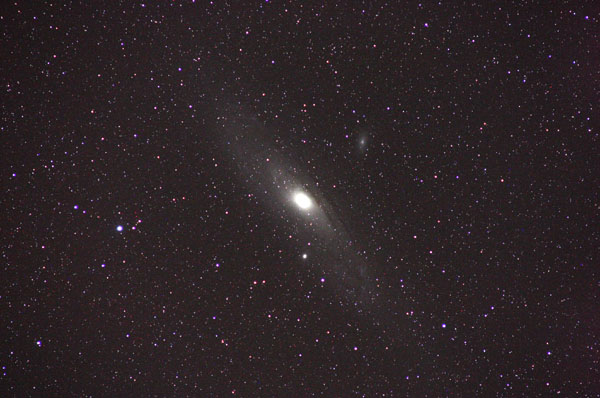
Last night I went out in the country and found the weather a good bit clearer than
last month. The full set of pictures, from last night and last month, will be
posted here soon.
In the meantime, the picture above is M31 the easy way.
All I did was piggyback the camera on an equatorially mounted, autoguided telescope,
and expose 6 minutes through a 300-mm lens at f/5.6. The camera was a Canon Digital Rebel
set to ISO 400, and the exposure is a single JPEG at "medium, smooth" resolution
(2.6 megapixels on a 6-megapixel camera, to reduce the effect of hot pixels).
I used Photoshop Elements to increase the contrast and resize the picture for the Web.
Apart from that, no processing was performed and no astronomy software was used.
No dark frame subtraction, no image stacking, nothing.
You can see that some hot pixels got through, such as a red one to the left of
center. But they are not any more prominent than the defects in a film
photo would probably have been.
The lesson? Digital astrophotography is easier than ever before.
Permanent link to this entry


|

|
2006
October
12-13
|
Mankiw's blog
Too busy to write anything of my own, I've just discovered the interesting
blog of Harvard economist
Greg Mankiw.
Two choice items:
a
defense of ROTC
(on-campus voluntary military training, which the University of Georgia has
but Yale and Harvard don't),
and an account of the
wanton destruction of potatoes
(to create a deliberate shortage)
by a money-hungry cartel.
Only if the world had too much food would that be conceivably justifiable.
By the way, my blog got 500 hits in the past 2 days, and a quick look at the
statistics did not make it evident why.
Does anybody know?
The same counter gets actuated whether people are going to current blog entries
or past ones.
Permanent link to this entry


|

|
2006
October
11
|
Stoic Syntax — What I was doing 28 years ago
 By popular demand, I've just placed on the Web something that may be my one and only
real contribution to our knowledge of the ancient Greek world:
a paper on
syntax in
Stoic logic.
This was written as a term paper for a course taught by Ruth Barcan Marcus
at Yale. I had taken a course at Cambridge under G. E. L. Owen that covered
the Stoic material fairly well. So much for my contact with eminent logicians...
By popular demand, I've just placed on the Web something that may be my one and only
real contribution to our knowledge of the ancient Greek world:
a paper on
syntax in
Stoic logic.
This was written as a term paper for a course taught by Ruth Barcan Marcus
at Yale. I had taken a course at Cambridge under G. E. L. Owen that covered
the Stoic material fairly well. So much for my contact with eminent logicians...
I haven't come across another equally concise presentation of the same information,
so now it's on the Web.
If you've studied logic, the Stoic system will probably strike you as
rather modern compared to Plato or Aristotle.
Stoic logic was an important precursor of the modern
mathematical logic of Boole and Carnap.
Yes, the paper is littered with Greek words.
Typing it on an IBM Selectric was a real adventure.
Permanent link to this entry
Why you should read this blog rather than CNN Money
Because I report the news sooner.
Compare
this
to
this.
Of course, they do give a lot more detail... :)
Permanent link to this entry


|

|
2006
October
10
|
Notes from all over
There was an occultation of the Pleiades last night; that is, the moon passed in front
of the most prominent star cluster in the sky. I found out about it by just wandering outside
and noticing that the moon was about where the Pleiades ought to be.
Then I got my binoculars, then the 5-inch telescope, and watched one disappearance
(that of Electra).
This is a spaceship-like experience — the star approaches the illuminated edge
of the moon and suddenly disappears behind it.
Closer to home, CNET reports the hazards of
online
shopping while drunk.
Now that you can shop in the privacy of your own home, without even talking on
the telephone, there's nothing to stop people who have had way too many.
Hmmm. I'm good at staying out of trouble, and this kind strikes me as particularly
easy to stay out of.
But I wonder if anyone has ever bought anything from me under such circumstances.
Turning to technology, Jeff Duntemann has good things to say about
Macromedia Flash as a
general-purpose programming language.
This commercial product (whose "player" is free) has reportedly accomplished what neither
Microsoft nor the WWW Consortium could do — establish a safe, powerful system for
building intelligence into web pages on the client side.


My super-thin scientific calculator has turned up.
This is fortunate, because nothing like it is made today.
It's a Radio Shack EC-4016,
solar-powered, and in spite of its low profile,
its keys are easy to identify and press due to their raised borders.
It has hex and binary, essential for computer geeks like me, as well as
trigonometry and degrees-minutes-seconds, handy for astronomy.
Last, have you encountered
The Ukulele
Orchestra of Great Britain?
Permanent link to this entry


|

|
2006
October
8-9
|
Darkroom work in the 21st Century

Even in 2006, our darkroom lives on.
Cathy is using it regularly for the art course she is taking; students still learn
how to use a manual SLR with Tri-X Pan film.
Labs are provided on campus, but she prefers to work at home, using the finely
tuned setup that I've been building since about 1979.
Today I did a bit of darkroom work myself.
The goal was to test my sister's Canon Rebel Ti, which is for sale
(please e-mail me if you want a good film SLR with two digital-ready zoom lenses, $300).
So I bulk-loaded a roll of Fuji Neopan 400 (expiration date 2000),
took pictures, and developed it using HC-110 developer that had been decanted into airtight
glass bottles (to make it last longer) five years ago.
Then I made prints. Everything came out fine. Above you see the result.
I do have some fresh supplies. On Saturday, I went to Atlanta and found that Wolf Camera's
new flagship store, on Piedmont near Peachtree, is much smaller than the old 14th-St. emporium
and does not carry darkroom supplies. (Heresy!) There are a few leftovers (in fact I snapped up a
box of satin-surfaced Ilford paper for Cathy), but you can no longer buy everything you need to
develop one roll of film or make one print. In particular, there was no developer of any sort.
The Athens store has lately had developer but no fixer.
My darkroom supplies came from Showcase, which is much less of a
mass-market place than Wolf is becoming, and which is committed to keeping darkroom materials
available. Their old rack of Ilford, Kodak, and Agfa paper had dwindled to just Ilford paper
and Ilford and Kodak chemicals (the latter somewhat incomplete; no Xtol,
for instance).
But everything essential was there, and just as importantly, it was fresh.
The Ilford products had the new (Harman Technology) labeling, indicating they were just
a few weeks old. The Kodak products have expiration dates; I got a new bottle of
HC-110 syrup, which will probably last me five years,
and by then I suppose Kodak will no longer be making it.
Permanent link to this entry


|

|
2006
October
6-7
|
Still more miscellany
Real work is interfering appreciably with hobbies, and my astrophotos from nearly
a month ago are not yet ready. I have to work over them with MaxIm DL and Photoshop;
the most crucial step is dark-frame subtraction, where from each picture I subtract an
identical exposure taken with the lenscap on, thereby removing the hot pixels.
Those pictures are coming... soon...
Meanwhile, a few interesting things I've seen on the Web.
Too many lights:
Here's a map of the
whole earth at night,
pieced together from satellite pictures.
It shows you where the electric lights are, especially the ones that are aimed upward.
You can see that Texas has much darker skies than Georgia, and you can see why
astronomers want to go to Australia.
Also, look at the boundary between India-Pakistan and the surrounding countries.
And look at how the Nile stands out as a white streak.
Modern history trivia: There is still a
Stuart
pretender to the throne of England
and a
Habsburg claimant
of the throne of Austria-Hungary.
If the House of Windsor and the current governments of Austria and Hungary go away, they're ready!
Coming economic crisis: Too much
student loan debt.
We have a whole generation going through college to emerge with tens of thousands of dollars of debt.
If they're well-paid doctors and lawyers, fine; but what if they're underemployed English majors
or (shudder!) linguists (like me)?
New ways to harm yourself:
According to New Scientist (in England), a tremendous number of mind-altering drugs are
not illegal because they've just been discovered
and, quite properly, a drug can't be banned until it has been identified and shown to be harmful.
Does that mean they're safe? Not on your life. "Try this, nobody knows what it will do to you..."
By the way, as someone involved in brain research, I should comment on recent claims that
marijuana may ward off Alzheimer's Disease.
Maybe it does, but that doesn't mean you should actually use it for that purpose!
The psychosis risk and other long-term effects of marijuana
are things I wouldn't want to inflict on anyone whose brain is somewhat frail to begin with.
What needs to happen, of course, is that various effects of marijuana on the brain need to be
disentangled by further research.
Shine on, harvest moon: Tonight's full moon is the Harvest Moon, so called because it
traditionally helps farmers harvest their crops. At this time of year, the full moon rises at nearly
the same time on two or three consecutive nights because it's moving north as well as east.
Also, because of the moon's off-center orbit, it happens to be closer to the earth tonight than usual,
although the difference isn't noticeable. You could demonstrate the difference by taking a picture of
it and then using the same lens or telescope to take another picture of the full moon about six
months from now.
Permanent link to this entry


|

|
2006
October
4-5
|
More miscellany
Online biology encyclopedia for everyone:
www.discoverlife.org.
It's one of the University of Georgia's most successful public outreach projects,
and I didn't know about it until today.
Massive use of solderless breadboards:
Check out this example.
An increasing number of electronics hobbyists are using solderless breadboards
for permanent construction.
Anything you build that way is rather flimsy and should never be turned upside down,
but I suppose that if it's treated gently, a prototype built this way will last
indefinitely.
Thin calculator wanted: About 23 years ago (yikes!) I bought a Radio Shack scientific
calculator that is less than 1/8 inch thick. Until recently, it rode around in my organizer.
Now I don't know where it's gone. Is anything like this manufactured today?
I want something with hex and binary if possible, not just a business calculator.
Creative use of oscilloscope parts: Look at Cathode
Corner. Just the thing for the true geek's living room.
U.S. national debt: Everybody knows the government spends too much money, but
according to this graph,
the national debt, as a percentage of gross domestic product, is lower now than in 1950.
Still, it's growing rather fast...
My next public appearance will be at the
Academia and God Forum
in downtown Athens, Georgia, this Friday night.
I'm speaking about the history of the Bible.
Happy birthday, Melody!
Permanent link to this entry


|

|
2006
October
2-3
|
Miscellanea photographica
More pictures are coming soon. In the meantime...
New web address: Try
www.DSLRbook.com.
For now, this links to some of my existing material, but
you can guess what's in the works.
More news as it happens.
Photographers should also look at
SoDoItYourself.com
and their handy homemade light box (made of sheets of paper).
Speaking of photography,
Ilford appears to be
completely out of financial danger and eager to acquire Kodak's ex-customers
now that Kodak no longer makes conventional black-and-white paper.
Judging from their equivalent-product charts, the Ilford people seem to think
Kodak may be about to drop black-and-white film and chemicals too.
Indeed, right now Kodak is selling chemicals to develop nonexistent Kodak papers,
and that situation can't last.
"Kodak... the digital X-ray-machine company... Grandpa can remember when they
used to make film!"
Nothing too earth-shaking came out of Photokina, the big industry show last month.
There are of course increments to the Nikon and Canon DSLR lines (D80 and 400D/XTi respectively).
But photo atavists will want to take note that
Rollei
has started making black-and-white film, and one of their products,
Rollei R3,
has some very unusual properties.
It is a multilayer film that can be used at speeds from ISO 25 to 6400 (they say)
and its sensitivity extends into the near-infrared at 710 nm (which may cost you some
sharpness with lenses that aren't optimized for wavelengths that long).
It is on a polyester base similar to Kodak ESTAR, much tougher than traditional film,
and the data sheet says that 120-size rolls tend to unroll themselves unexpectedly!
(Hmmm...)
Reciprocity failure is not too severe, so
this may be a film for astronomers to use photographing nebulae
(if any of us haven't switched to CCDs yet).
[Note added Oct. 4: Reciprocity failure is less than with Kodak Tri-X Pan.
It is still substantial compared to hypersensitized film or new-generation
color film.]
The development procedure calls for a water prewash and an unusually long
developing time (14 minutes in HC-110 B).
Will I get around to trying it? Maybe. This and the other items in the product line may
be the last new black-and-white films the world ever sees.
Or maybe, as Cathy observes, the market for black-and-white film is going to be
like the market for artists' oil paint — it will never entirely go away,
and if a manufacturer can be content to serve a small market, there will always
be money to be made.
Permanent link to this entry


|

|
2006
October
1
|
Pictures!
I've finally processed my digital images from a trip out into the country on September 14.
(Those from September 15 and September 19 are coming.)
Here are the two best. Each was made by combining 5 3-minute exposures taken with a
Canon Digital Rebel through an 8-inch telescope at f/6.3.
First, the Omega Nebula (M17):
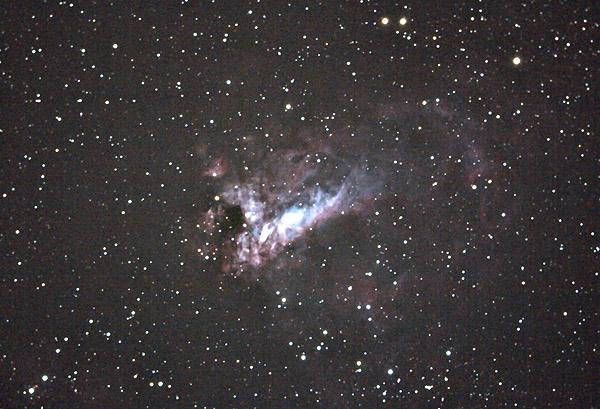
Color-corrected picture posted December 20.
Next, the Veil Nebula, NGC 6992. This is a very faint remnant of an ancient
supernova. I'm pleasantly surprised to have captured it with an unmodified camera.
Normally, the infrared-blocking filter of a DSLR has to be removed,
or replaced with a modified one, to record
hydrogen nebulae well.
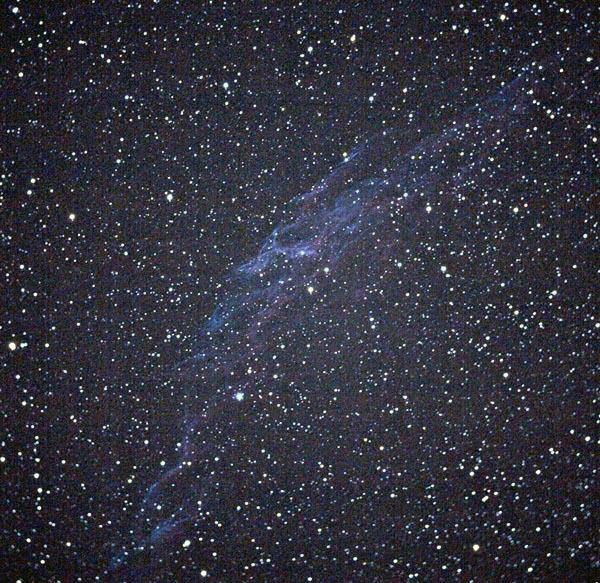
Color-corrected picture posted December 20.
Permanent link to this entry
The pin in the real-estate bubble
And now for a completely different topic.
I'm no economist, but I've noticed something.
Thanks to rising interest rates and unconventional mortgages, there are now plenty of
Americans who have to sell their houses soon, whether the market
is good or not, because they can't keep up with rising payments.
Many of these loans are "interest-only" for the first 5 years
(or 1 year),
and then the payment goes up sharply to start paying down the principal.
Nastier yet, there are loans where the payments will convert from interest-only
to principal-and-interest at an unpredictable date if rising interest rates
have caused negative amortization.
Of course, everybody thinks they're going to sell the house at a great profit
within just a couple of years.
And if everybody weren't having to do it at the same time, they might be OK.
Our friends at
the Fed and the FDIC
have noticed all this and have issued some new
recommendations
and
sample
advice to customers.
(They don't want either the banks or the customers to go broke.)
Some highlights:
- "Collateral-dependent loans" are bad banking. A collateral-dependent loan is one where
the borrower is expected to sell the collateral in order to pay off the loan.
(Houses aren't sold in pawn shops — yet!)
- Credit scores are no substitute for proof of income. Remember (what banks sometimes forget)
that a credit score is mainly about whether you pay your bills on time, and your income
actually isn't factored into it.
- Banks must be perfectly sure that the customer knows what's coming if the payments are
going to rise.
So that's how we prevent the next bubble. This time, the horse is already out of the barn...
Permanent link to this entry


|

|
